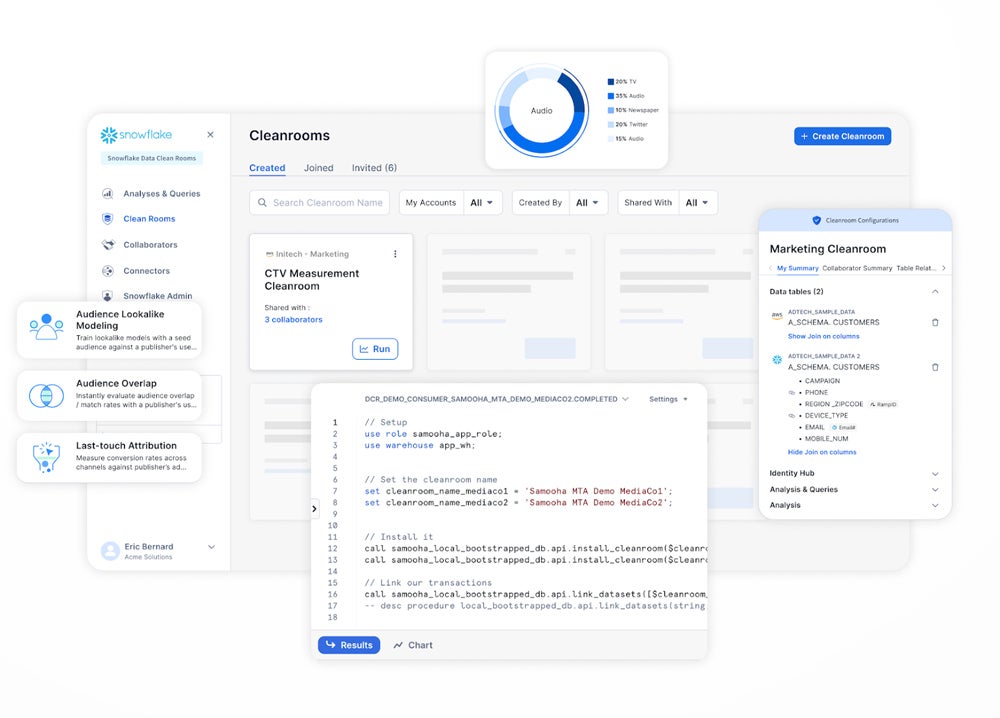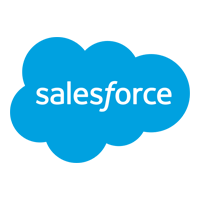Databricks and Snowflake are two of the top data-focused companies on the market today, each offering their customers unique features and functions to store, manage, and use data for various business use cases.
Databricks got its start as a robust tool for configurable data science and machine learning projects, while Snowflake began as a cloud data warehouse solution with business intelligence and reporting capabilities.
The two have continued to roll out new features that have grown their impressive solutions portfolios and transformed them into direct competitors. Knowing how they compare on key features, pricing, ease of use, and other key areas can help your organization determine which might better meet your needs.
KEY TAKEAWAYS
Databricks is best for complex data science, analytics, ML, and AI operations that need to scale efficiently or be handled in a unified platform.
Snowflake is best for data warehousing and accessible BI features.
Compared to Snowflake, Databricks offers more maturity in ML operations, data science, and both scalable and customizable data processing capabilities.
Compared to Databricks, Snowflake offers a more approachable user interface for more straightforward data processes—its extensive integrations, marketplace, and partner network enable more complex projects.
Databricks vs. Snowflake Comparison
The follow table shows how Snowflake and Databricks compare across key metrics and categories.
| Best for Scalable Pricing and Performance | Best for Data Operations and Capabilities | Best for Multiple Data Types | Best for Support and Ease of Use | Best for Security | Best for AI Features | |
|---|---|---|---|---|---|---|
| Databricks | Dependent on Use Case | ✅ | ✅ | ✅ | ||
| Snowflake | Dependent on Use Case | ✅ | ✅ |
TABLE OF CONTENTS

Databricks Overview
Databricks is a data-driven platform-as-a-service (PaaS) vendor with services that focus on data lake and warehouse development as well as AI-driven analytics, automation, complex data processing, and data science. Its flagship lakehouse platform includes unified analytics and artificial intelligence management features, governance capabilities, machine learning, and data warehousing and engineering.
The design of Databricks ensures that all AI, data, and analytics operations and resources are unified within the platform—primarily through Unity Catalog—which means fewer third-party tools are necessary to complete data and AI operations. This is especially effective if you’re working with unstructured, semi-structured, and structured data formats.
Users can access certain platform features through an open-source format. When this feature is combined with its Apache Spark foundation, Databricks offers a highly extensible and customizable solution for developers. It’s also a popular solution for data analysts and scientists who want to incorporate other AI or IDE (integrated development platform) deployments into their setup.
Key Features
Databricks stands out for a number of key features, including the following:
- Data Lakehouses: This unique storage approach was pioneered by Databricks to combine the strengths of data lakes and data warehouses into one infrastructure. With this approach, users can increase data governance and data storage capabilities while also reducing storage costs. In many cases, this infrastructure is also more flexible and compatible with data analytics operations than either a data warehouse or a data lake.
- Unity Catalog: This aspect of the Databricks Data Intelligence Platform provides users with a unified and open governance solution for data and AI. Users frequently select this tool because it allows them to organize, prepare, and operationalize their data—as well as their teams’ permissions—without needing third-party tools to do this work.
- Databricks Solution Accelerators and Notebooks: Prebuilt accelerators provide the notebooks, blueprints, and other resources necessary for teams that want to quickly get started with data analytics and data science projects. Accelerators are organized by industry and cover a lot of ground; Python-based notebooks are a huge favorite.
- Data Intelligence Engine: This feature runs in the background to support complex data operations that are customized to your exact data types and requirements. This engine enables semantic data understanding, easier data search and discovery, and natural language support for coding and troubleshooting.

Pros
- Pioneering data lakehouses and other scalable data stores and structures
- Unified approach to data cataloging, governance, and analytics eliminates tool sprawl
Cons
- Expensive and complex pricing approach with Databricks Units (DBUs)
- Highly technical platforms with steep learning curves

Snowflake Overview
Snowflake is a major cloud and data company that focuses on SaaS-delivered data-as-a-service functions for big data operations. Its core platform is designed to seamlessly integrate data from various business apps and in different formats in a unified data store. Consequently, typical extract, transform, and load (ETL) operations may not be necessary to get the data integration results you need.
The platform is compatible with various types of business workloads, including artificial intelligence and machine learning, data lakes and data warehouses, and cybersecurity workloads. It is ideally designed for organizations that are working with large quantities of data that require precise data governance and management systems in place or on-demand storage.
Compared to Databricks, Snowflake is better set up for users who want to deploy a high performance data warehouse and analytics tool rapidly without bogging down in configurations, data science minutia, or manual setup. But this isn’t to say that Snowflake is a light tool or for beginners. Far from it; it’s a highly advanced platform known for its clear user interface.
Key Features
Snowflake offers a number of key features that help it stand out from competitors, including the following:
- SQL Data Warehousing: Snowflake is a longtime leader in cloud data warehousing, offering a large-scale infrastructure that requires little to no maintenance on the part of the user. Its SQL base makes it particularly accessible to users of varying technical skill levels.
- Snowpark: This newer AI and ML feature is designed to support containerized application development and deployment. It’s also great for data engineering and data pipeline design.
- Marketplace and Partner Network: Snowflake has an extensive marketplace with products that span across categories, business needs, and price points. Its partner network is also impressive, offering dozens of strategic partners across AI data cloud, cloud services, and cloud platform infrastructure.
- Data Clean Rooms: The Data Clean Rooms feature takes role-based access control to more sophisticated and granular levels, making it possible to develop very specific audiences that can overlap or sit separately in whatever ways you choose. The setup makes it very easy to see levels and areas of access for different users.

Pros
- Strong and diverse marketplace for users
- Platform is generally easy to use and set up
Cons
- Less focus and fewer capabilities in advanced data science and analytics
- Limited experience with and maturity in AI and ML use cases
Best for Scalable Pricing and Performance: Depends on Use Case
There is a great deal of difference in how Databricks vs Snowflake are priced. But speaking very generally for the average business user: Databricks typically comes out to around $99 a month, while Snowflake usually works out at about $40 a month.
Again, it isn’t as simple as that, because each tool has different components and plans that have their own pricing variables. It’s especially complicated because each tool is priced per unit or credit used, which can be highly variable from month to month. To add more complexity to this problem, there’s a good chance you’ll also have costs associated with running some of these tools’ processes on AWS, Azure, or GCP.
Here’s a breakdown of what each of these pricing structures looks like:
Databricks Pricing
- Workflows: Starting at $0.15 per DBU
- Delta Live Tables: Starting at $0.20 per DBU
- Databricks SQL: Starting at $0.22 per DBU
- Interactive Workloads: Starting at $0.40 per DBU
- Mosaic AI: Starting at $0.07 per DBU
Snowflake Pricing
- Standard: Starting at $2 per credit
- Enterprise: Starting at $3 per credit
- Business Critical: Starting at $4 per credit
- Virtual Private Snowflake (VPS): Pricing information available upon request
- On-Demand Storage: $23 per TB per month
Snowflake keeps compute and storage separate in its pricing structure, so pricing will vary tremendously depending on the workload and the pricing tier you select. However, if you have pretty consistent storage requirements from month to month, Snowflake may be a more affordable solution.
Compute pricing for Databricks is also tiered and charged per unit of processing. As storage is not included in its pricing, Databricks may work out cheaper for some users. It all depends on the way the storage is used and the frequency of use.
The differences between them make it difficult to do a full apples-to-apples pricing comparison. Users are advised to assess the resources they expect to need to support their forecast data volume, amount of processing, and their analysis requirements. For some users, Databricks will be cheaper, but for others, Snowflake will come out ahead.
This category is a close competition as it varies from use case to use case.
Best for Data Operations and Capabilities: Databricks
Snowflake is high performing for interactive queries as it optimizes storage at the time of ingestion. It also excels at handling BI workloads and the production of reports and dashboards, and it excels as a data warehouse. Some users note, though, that it struggles when faced with huge data volumes found with streaming workloads. It also has fairly limited data science and processing features built into the solution because of its emphasis on data warehousing and ease of use.
In contrast, Databricks isn’t really a data warehouse at all. Its data platform is wider in scope with better capabilities than Snowflake for ELT, ETL, data science, and machine learning. Users store data in managed object storage of their choice, allowing the platform to focus on data lake infrastructure and complex, high-volume data processing initiatives. It is squarely aimed at data scientists and professional data analysts and offers the complexity of tools necessary to handle a wide variety of their strategic tasks.
In a straight competition on data warehousing capabilities, Snowflake wins, but for virtually all other data operations and capabilities, Databricks is a more mature and capable solution.
Best for Working With Multiple Data Types: Databricks
While both Databricks and Snowflakes technically allow you to work with all data types, the process for getting there is quite different. Databricks is automatically compatible with all data types: structured, semi-structured, and even unstructured data all work in the platform. This is due to its lesser emphasis on data storage and greater infrastructure for data processing and data science. Users can input data in any format into the platform, and built-in ETL and ELT tools are available to make any formatting adjustments if necessary.
In contrast, Snowflake natively offers support only for semi-structured and structured data. It also does not have as much built-in ETL and ELT functionality to support any necessary data transformation work for unstructured data. However, its integration marketplace is incredibly robust and connected to many different solutions that can prepare unstructured data for use in Snowflake. So, if you are already using a separate ETL/ELT tool or are willing to invest in one, you’ll still be able to work with all different data types in Snowflake with relative ease.
While it is possible to work with all different data types in both Databricks and Snowflakes, Databricks takes the win due to its native compatibility with structured, semi-structured, and unstructured data.
Best for Support and Ease of Use: Snowflake
The Snowflake data warehouse configuration is user-friendly, with an intuitive SQL interface that makes it easy to get set up and running. It also has plenty of automation features to facilitate ease of use. Auto-scaling and auto-suspend, for example, help in stopping and starting clusters during idle or peak periods. Clusters can be resized easily.
Databricks, too, has auto-scaling for clusters. The UI is more complex for more arbitrary clusters and tools, but the Databricks SQL Warehouse uses a straightforward “t-shirt sizing approach” for clusters that makes it a user-friendly solution as well. Both tools emphasize ease of use in certain capacities, but Databricks is intended for a more technical audience, so certain steps like updating configurations and switching options may involve a steeper learning curve.
Both Snowflake and Databricks offer online, 24/7 support, and both have received high praise from customers in this area.
Though both are top players in this category, Snowflake wins for its wider range of user-friendly and democratized features.
Best for Security: Snowflake
Snowflake and Databricks both provide role-based access control (RBAC), encryption, and activity monitoring features to protect security and privacy in their platforms. Both data vendors also comply with SOC 2 Type II, ISO 27001, HIPAA, GDPR, and more.
In addition to these more standard security features, Snowflake maintains its own secure cloud infrastructure with continuous monitoring, independent security audits, and unique, more granular role-based access controls like Data Clean Rooms. Snowflake also adds network isolation and other robust security features in tiers, with each higher tier costing more. But on the plus side, you don’t end up paying for security features you don’t need or want.
Databricks, too, includes plenty of valuable security features, but it’s important to note that many of these features require users to do more configuration. Since Databricks is a more complex platform and requires more hands-on user intervention for security to work effectively, that may lead to Databricks having more security misconfigurations and gaps over time compared to Snowflake; obviously this relies on staff resources.
While both platforms offer a range of useful security features that are similar to each other’s solutions, Snowflake wins due to its more automatic and simple security configuration model.
Best for AI Features: Databricks
Both Snowflake and Databricks include a broad range of AI and AI-supported features in their portfolio, and the number only seems to grow as both vendors adopt generative AI and other advanced AI and ML capabilities.
Snowflake supports a range of AI and ML workloads, and in more recent years has added the following three AI-driven solutions to its portfolio: Snowpark, Streamlit, and Arctic. Snowpark offers users several libraries, runtimes, and APIs that are useful for ML and AI training as well as MLOps. Streamlit can be used to build a variety of model types — including ML models — with Snowflake data and Python development best practices. And Arctic offers Snowflake-built enterprise LLM models to users with an emphasis on open design and enterprise-ready infrastructure.
Databricks, in contrast, has more heavily intertwined AI and ML in all of its products and services and for a longer time. The platform includes highly accessible machine learning runtime clusters and frameworks, autoML for code generation, MLflow and a managed version of MLflow, model performance monitoring and AI governance, and tools to develop and manage generative AI and large language models.
Other AI-driven features include feature engineering, vector search, lakehouse monitoring, AI governance, and AI security. AI is intentionally embedded into all corners of Databricks, while Snowflake’s AI solutions essentially sit on top of or come as an add-on for their existing solutions.
While both vendors are making major strides in AI, Databricks takes the win here.
Who Shouldn’t Use Databricks or Snowflake?
Databricks vs Snowflake is an important comparison to make when considering an enterprise-ready data and AI solution for your business, but in some cases, neither solution will offer the features and usability you seek.
The following users might want to consider alternatives to Databricks:
- Users with little experience with or knowledge of Spark and Python
- Less technical users
- Users with predictable, smaller-scale storage requirements
- Users who want a straightforward, easy-to-use, and easy-to-configure solution
- Users who need completely predictable pricing structures
- Users who want prebuilt security features that require little to no implementation
The following users might want to consider alternatives to Snowflake:
- Users who want a completely unified approach to data storage, management, and analytics
- Users who want extensive machine learning functionality
- Users who need support and features for unstructured data
- Users with highly variable or large-scale data processing requirements
- Users looking for a highly customizable Apache Spark back-end
- Users who need completely predictable pricing structures
Best 3 Alternatives to Databricks and Snowflake
If any of the bullet points above felt relevant to your concerns when comparing Databricks vs Snowflake, we recommend considering alternatives such as Yellowfin, Salesforce Data Cloud, and Zoho Analytics.

Yellowfin
Yellowfin is an embedded analytics and BI platform that combines action-based dashboards, AI-powered insight, and data storytelling. With this solution, users can connect to all of their data sources in real time. It’s also possible to configure Yellowfin to allow multiple tenants within a single environment. Additionally, Robust data governance features are incorporated to ensure compliance. Many users select Yellowfin for its flexible pricing model that is simple, predictable, and scalable, as well as for its interactive visualizations that improve decision-making.

Salesforce Data Cloud
Particularly for users who need advanced data solutions for marketing, sales, or service scenarios, Salesforce’s Data Cloud is a great solution to activate all your customer data across Salesforce applications. This solution empowers teams to engage customers at every touchpoint with relevant insights and contextual data in the flow of daily work. Companies use this solution to connect their data with an AI CRM; this simplifies the process of deriving relevant data and insights from your existing Salesforce processes and applications.

Zoho Analytics
Zoho Analytics is a software solution that enables users to perform self-service business intelligence and data analytics operations. It is ideal for users that need an easy way to analyze content in various files, apps, and databases. Customers frequently praise the quality and usability of Zoho Analytics visual elements, including its user-friendly reports and dashboards. And, particularly for smaller teams and requirements, Zoho Analytics is an incredibly affordable data analytics solution.
How We Evaluated the Systems
While several other variables impacted research for this comparison guide, the following review categories framed our comparison through the lens of what matters most to Databricks and Snowflake customers.
Mature Data Management Capabilities | 50 percent
Considering both Databricks and Snowflake are enterprise-tier data platforms, I spent significant time researching the data operations and features that are possible with each platform. I looked most specifically at compatibility with different data formats, data storage infrastructure, data management and processing capabilities, data science features, data ownership, data operations scalability, data sharing approach, ETL and other data transformation capabilities, and how data operations integrate with ML and AI operations.
Ease of Use and Support | 25 percent
Because data processes can be complex, especially for less-technical teammates outside of the data analysts’ department, I also reviewed how each vendor made its platform more approachable and user-friendly. This component of my review focused on looking for a clean and accessible interface, natural language configuration capabilities, auto-configuration features, customer support accessibility and resources, customer reviews about ease of use and their general experience with the platform.
Enterprise-Ready Solutions and Growth | 25 percent
Ultimately, both Databricks’ and Snowflake’s existing features—not to mention the new data and AI features their vendors are pursuing—are designed for an enterprise audience with complex use cases and requirements. This is why a large portion of my research process focused on finding unique differentiators that indicated each platform’s scalability and ability to handle big data and complicated working scenarios.
I primarily looked for unique AI and ML features and a growing solutions stack in this area; a robust marketplace and partner network; sophisticated and comprehensive cybersecurity, privacy, and admin features; compatibility with third-party enterprise tools, especially major cloud platforms; customizability; and a unified interface that still plays nicely with other enterprise tools in the customer’s tech stack.
Bottom Line: Databricks vs. Snowflake Depends on Your Overall Data Strategy
Snowflake and Databricks are both excellent solutions for data analytics and management purposes, and each has distinct pros and cons. Choosing the best platform for your business comes down to usage patterns, data volumes, workloads, in-house expertise and ultimately, your company’s overall data strategy.
In summary, Databricks wins for a technical audience with high-level and dynamic requirements, while Snowflake is highly accessible to both a technical and less-technical user base. Databricks provides pretty much every data management feature offered by Snowflake, with several additional features for data science and processing. But it isn’t quite as easy to use, has a steeper learning curve, and requires more maintenance. Snowflake vs. Databricks should be a fairly straightforward decision to make, as their purposes and niches are relatively distinct and uniquely strategic.
For an in-depth look at the leading ML tools for enterprise use cases, see the eWeek guide: Best Machine Learning Platforms